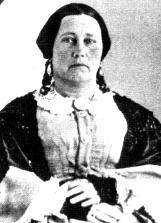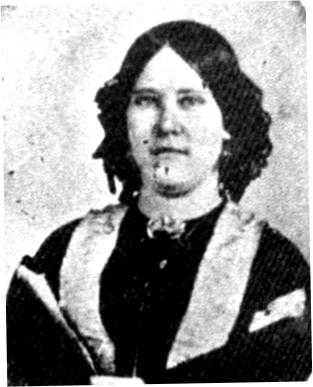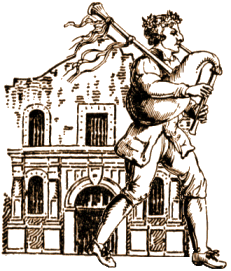

Some of the interesting stories about the battle at the Alamo
involved the music performed both inside and outside the Alamo
as the confrontation and battle progressed.
On February 23, 1836 Santa Anna had reclaimed San Antonio.
To the triumphant music of a military band, he took possession
of the town, set up headquarters on the main plaza, and began
the siege. He had his standard-bearers climb to the top of the
bell tower of San Fernando Church and unfurl the scarlet flag of "no
quarter." Inside the Alamo, Travis and the Texans fired their
message to Santa Anna with a blast from their 18-pounder. They
had their music, too, with Davy Crockett's fiddle and John McGregor's
bagpipes. In fact, Davy's fiddle-playing and outlandish storytelling
kept up the spirits of the besieged defenders.
 Santa
Anna ordered his men to pound the fortifications with cannon and
rifle fire for 12 days and nights. His idea was to wear out the
defenders inside, giving them no chance for rest or sleep. He reasoned
that a weary army would be an easy one to defeat. But the noise
worked on his own army, too. Unable to hear clearly through the
din, they allowed courier after courier to escape from the Alamo.
On March 2, racing through the enemy's lines, the last group to
reinforce the Alamo arrived. These men were the relief force from
Gonzales (my wife's ancestor Isaac Millsaps was one of these men),
the only town to answer Travis' pleas to send help. The total number
of Alamo defenders now stood at between 180 and 190. Santa
Anna ordered his men to pound the fortifications with cannon and
rifle fire for 12 days and nights. His idea was to wear out the
defenders inside, giving them no chance for rest or sleep. He reasoned
that a weary army would be an easy one to defeat. But the noise
worked on his own army, too. Unable to hear clearly through the
din, they allowed courier after courier to escape from the Alamo.
On March 2, racing through the enemy's lines, the last group to
reinforce the Alamo arrived. These men were the relief force from
Gonzales (my wife's ancestor Isaac Millsaps was one of these men),
the only town to answer Travis' pleas to send help. The total number
of Alamo defenders now stood at between 180 and 190.
And the rest is history.
Colonel Davy Crockett and Sergeant
John McGregor apparently provided some lively and loud rounds of
music while performing on the fiddle and the bagpipes. As some
tell the story, this music coming from the Alamo during lulls in
the fighting really aggravated Santa Anna and his men. We don't
know for sure if it was the particular tunes they played that aggravated
the invaders, or was it just the fact that the Texicans and their
allies were there in the Alamo partying right up to the night before
the big battle? Supposedly Santa Anna's men responded with their
own music
that marked the pre-battle occasion.
One story tells it like this:
At 4 o'clock on the morning of March 6, 1836, Santa Anna advanced his men to
within 200 yards of the Alamo's walls. Just as dawn was breaking, the Mexican
bloodcurdling bugle call of the Deguello (MP3) echoed the meaning of the
scarlet flag above San Fernando: no quarter. It was Captain Juan Seguin's Tejanos,
the native-born Mexicans fighting in the Texan army, who interpreted the chilling
music for the other defenders.
  Amongst
the few survivors of the Alamo was the young wife (Susanna,
pictured at the right) and daughter (Angeline, pictured at the
left) of Lieutenant Alman Dickinson. A story told was Susanna Dickinson's
account of John McGregor and his bagpipes. She said that when the
fighting would lull, and the defenders had time for a rest, John
McGregor and David Crockett would give sort of a musical concert,
or rather a musical competition, to see which one could make the
most noise; Crockett with his fiddle or McGregor with his bagpipes.
She said, "McGregor always won so far as noise was concerned, for
he made strange and dreadful sounds with his queer instrument." Amongst
the few survivors of the Alamo was the young wife (Susanna,
pictured at the right) and daughter (Angeline, pictured at the
left) of Lieutenant Alman Dickinson. A story told was Susanna Dickinson's
account of John McGregor and his bagpipes. She said that when the
fighting would lull, and the defenders had time for a rest, John
McGregor and David Crockett would give sort of a musical concert,
or rather a musical competition, to see which one could make the
most noise; Crockett with his fiddle or McGregor with his bagpipes.
She said, "McGregor always won so far as noise was concerned, for
he made strange and dreadful sounds with his queer instrument."

The legendary Davy Crockett was a skilled
fiddler and buck dancer, some believe that the
piece "Col.
Crockett's Reel," published
as early as 1839 was earlier composed and played
in one version by Crockett himself. It is still
played today under the name "The
Route".
 McGregor, John. (18?? - 1836) Scottish (believed
to have been born in Aberfeldy in Perthshire), resided
in Nacogdoches, Texas. Piper. In 1835, joined the volunteer
rebel army as an artilleryman when the Texas Revolution
began. Went on to serve in the garrison of the Alamo as a
2nd Sergeant of artillery and probably commanded a battery
of guns on the Alamo walls, where he was killed during the
Mexican assault of March 6, 1836. His age is variously given
as 27, 28, or 34 years. Best remembered as "The Alamo Bagpiper" and
several survivors later recalled how during lulls in the
battle McGregor would play along (and also musically duel)
with Davy Crockett's fiddle music to keep up the spirits
of the defenders. (Entry from BagpipeJourney.com's Who's Who in Bagpiping, used with permission.) McGregor, John. (18?? - 1836) Scottish (believed
to have been born in Aberfeldy in Perthshire), resided
in Nacogdoches, Texas. Piper. In 1835, joined the volunteer
rebel army as an artilleryman when the Texas Revolution
began. Went on to serve in the garrison of the Alamo as a
2nd Sergeant of artillery and probably commanded a battery
of guns on the Alamo walls, where he was killed during the
Mexican assault of March 6, 1836. His age is variously given
as 27, 28, or 34 years. Best remembered as "The Alamo Bagpiper" and
several survivors later recalled how during lulls in the
battle McGregor would play along (and also musically duel)
with Davy Crockett's fiddle music to keep up the spirits
of the defenders. (Entry from BagpipeJourney.com's Who's Who in Bagpiping, used with permission.)
He
holds a special place in the history of the Alamo,
especially through his musical duels with Davy Crockett.
They had a competition over who could play the longest
and the loudest and of course, in something of a
mismatch, John McGregor won, no contest.
|
Below are a few MP3 arrangements
of bagpipe and fiddle pieces of the type that could have been
performed in the legendary music jamming duel at the Alamo.
The image of Crockett and McGregor, staring in the face of near certain death, and jamming, playing lively music and having a sort of wild party at the Alamo, some say even at times playing on the walls of the Alamo, likely infuriated the Mexicans and their little dictator leader, as well as being one of the classic and most touching scenes in military history.
A North Highland Reel
Ma Hurraman
Colonel Crockett
Highland Laddie
Maol Non Crogan
All arrangements
- Copyright 2008, All Rights Reserved.
This is a very interesting account
of the battle for the Alamo (which by the way is different
than commonly accepted versions) published in a newspaper in
Georgia, in 1836. We have included a transcript of the article
below.

Late and Important from Texas.
MASSACRE OF THE GEORGIA BATTALION!!!
From the Columbus ( Ga .) Herald, of
the 19th {Begin inserted text} April 1836. {End
inserted text} {Begin deleted text} instant. {End
deleted text}
The distressing news has reached us of the horrible massacre
and butchery of the entire command of Colonel Fannin, by
the tyrant monster Santa Anna and his forces. Colonel F. commanded
the Georgia Battalion, and his fall must consequently carry
deep distress and anguish into the bosom of many a bereaved
family. Our last advices stated that Colonel F. being overpowered
by the Mexicans, demolished his fortifications and fled
before the superior foe; and that in the effort to regain the
main body of the Texian Army under General Houston, on the
east side of the Colorado river, he had been intercepted by
the Mexicans, and driven to the flats. A letter received in
this city, by Gen Bethune from his friend, Mr. Lampkin, who
had retired from that country with his family, and wrote from
on board a vessel bound for New-Orleans, gives a full and detailed
history of the barbarous and inhuman affair. The men under
the immediate command of Colonel Fannin, were all killed
but five. Among those who escaped were Richard Rutledge, formerly
of this place, and David I. Holt, from Macon. A party of
70 under Col. Johnson were cut off, and all put to the sword
but four: our fellow townsmen John Love, was so fortunate as
to make his escape from the party. Reuben Brown and W. J. Mitchell
of Harris county, Captain Wardsworth and Major Ward, were
among the slain--all perished doing desperate battle.
The letter further states that Colonel Fannin capitulated
upon the promise of Santa Anna, that himself and soldiers should
be treated as prisoners of war. But no sooner had the fiend
of hell fastened them in his clutches, than he secured their
arms, and early next morning, ordered them all to be shot.
Nero was a merciful man compared with this monster, and the
Autocrat of Russia, will blush to read his history.
P. S. Since writing the above, General Bethune has very politely
tendered us the letter referred to, for publication. The following
is a copy:
On board Schooner DeKalb,
Mississippi River, April 7, 1836.
Dear Sir--You are no doubt some what surprised at the heading
of this page; but a few words will explain all. I am on board
of one of a number of vessels that are laden with the unfortunate,
who are flying from the terrors of war. You have perhaps heard
of the storming of St. Antonio, and massacre of the Texian
garrison. All without an exception perished, save a woman and
two negroes. Davy Crockett was among the number. He had fully
sustained his great character for intrepidity, during an unsuccessful
attempt of the enemy to storm the Alamo, just one week before
the massacre. A short time previous to this, a party of sixty
or seventy under Colonel Johnson, were cut off, save four.
John Love was among the number who escaped. Reuben Brown fell
here, and young Mitchell of Harris county, fell in the Alamo.
The taking of the Alamo was followed by the retreat of the
main army from Gonzales, and by the extermination of Fannin's
regiment, 500 strong. Major Ward, and the Georgia Battalion
(Captain Wardsworth's company included) had been detached by
Fannin, then at the Bahia to protect some families who were
flying from the enemy; when they were attacked, and after fighting
and retreating for nearly two days, were at length overpowered
by numbers, and all put to the sword, but five who escaped,
and only two of the Georgians; one was Richard Rutledge, formerly
of Columbus, and the other David I. Holt.
In the mean time, Fannin had received orders to abandon the
fortress of La Bahia, which he immediately executed, and returned
towards the main army with the balance of his troops, 360 men,
and seven pieces of artillery, where they were attacked in
an open prairie by a large Mexican force, mostly cavalry. A
small advance guard having been separated from the main body,
saw the fight, but could not tell the result. The termination
of this unhappy affair, was explained by three men who escaped
about the time of the catastrophe. Fannin sustained a great
many charges in quick succession, sustaining some damage, and
doing much execution; and kept retreating during the fight,
which lasted the greater part of a day, until he gained some
post oak woods, when the Mexicans ceased their charges, but
closely invested the place on all sides. Here Fannin received
propositions from the enemy, and capitulated upon the promise
of the Mexicans, that they should be treated as prisoners of
war. Their arms were immediately secured, and the next morning
they were all shot, save the three who escaped. Mrs. Fannin
had just arrived in Texas, but not in time to see her husband.
Many other barbarities have been committed. The army of Texas
after making a stand for a short time on the Colorado,
has retreated to the east side of the Brassos. San Phillippe
is burnt (by the citizens) and there is a probability that
Brazoria and Washington have shared the same fate. I do not
expect that there are half a dozen families West of the Brassos.
The enemy is known to be marching into the country in two divisions,
of 2,000 men each; one through the interior upon San Phillippe
and the other along the coast towards Velasco. They were
constantly expected at the latter place when I left it, and
the advance of the other division had already reached San Phillippe.
The Indians had begun to be troublesome, and many negroes have
runaway -- in some instances whole plantations of them
had gone off in a body, but had done no further mischief. Very
many families and negroes were going eastward, some for the
United States by land, and by water--others are making a stand
in the east, covered by the army.
|


The Cider Press Unique PDF ebook collection for historical researchers,
music history researchers and for the just plain curious folks out there....
|
Explore - The Amaranth Publishing web pages  including the music of the spheres, the music of a Renaissance alchemist, music created by software and artificial intelligence, the music of the fairies, the music of the Illuminati, the world's most mysterious book, the world's oldest song, a way you can compose music like Mozart, the world's oldest love song, including the music of the spheres, the music of a Renaissance alchemist, music created by software and artificial intelligence, the music of the fairies, the music of the Illuminati, the world's most mysterious book, the world's oldest song, a way you can compose music like Mozart, the world's oldest love song,
and much more........ |
|
Santa Anna ordered his men to pound the fortifications with cannon and rifle fire for 12 days and nights. His idea was to wear out the defenders inside, giving them no chance for rest or sleep. He reasoned that a weary army would be an easy one to defeat. But the noise worked on his own army, too. Unable to hear clearly through the din, they allowed courier after courier to escape from the Alamo. On March 2, racing through the enemy's lines, the last group to reinforce the Alamo arrived. These men were the relief force from Gonzales (my wife's ancestor Isaac Millsaps was one of these men), the only town to answer Travis' pleas to send help. The total number of Alamo defenders now stood at between 180 and 190.
Amongst the few survivors of the Alamo was the young wife (Susanna, pictured at the right) and daughter (Angeline, pictured at the left) of Lieutenant Alman Dickinson. A story told was Susanna Dickinson's account of John McGregor and his bagpipes. She said that when the fighting would lull, and the defenders had time for a rest, John McGregor and David Crockett would give sort of a musical concert, or rather a musical competition, to see which one could make the most noise; Crockett with his fiddle or McGregor with his bagpipes. She said, "McGregor always won so far as noise was concerned, for he made strange and dreadful sounds with his queer instrument."

 including the music of the spheres, the music of a Renaissance alchemist, music created by software and artificial intelligence, the music of the fairies, the music of the Illuminati, the world's most mysterious book, the world's oldest song, a way you can compose music like Mozart, the world's oldest love song,
including the music of the spheres, the music of a Renaissance alchemist, music created by software and artificial intelligence, the music of the fairies, the music of the Illuminati, the world's most mysterious book, the world's oldest song, a way you can compose music like Mozart, the world's oldest love song, 







